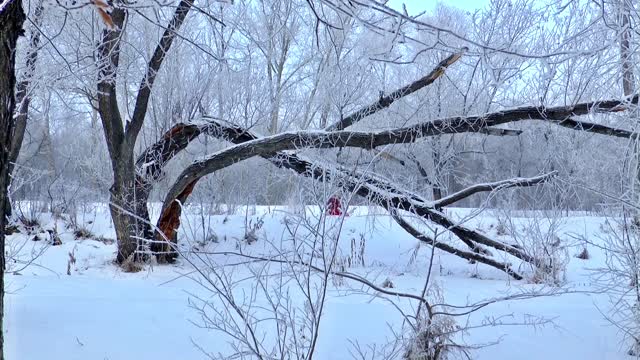Premium Only Content

Male Dog Running After Female Dogy In Snowy Day
Has your pet had his/her preventive care exam (wellness exam) yet? Cold weather may worsen some medical conditions such as arthritis. Your pet should be examined by a veterinarian at least once a year, and it's as good a time as any to get him/her checked out to make sure (s)he is ready and as healthy as possible for cold weather.
Just like people, pets' cold tolerance can vary from pet to pet based on their coat, body fat stores, activity level, and health. Be aware of your pet's tolerance for cold weather, and adjust accordingly.
You will probably need to shorten your dog's walks in very cold weather to protect you both from weather-associated health risks. Arthritic and elderly pets may have more difficulty walking on snow and ice and may be more prone to slipping and falling.
Long-haired or thick-coated dogs tend to be more cold-tolerant, but are still at risk in cold weather. Short-haired pets feel the cold faster because they have less protection, and short-legged pets may become cold faster because their bellies and bodies are more likely to come into contact with snow-covered ground.
Pets with diabetes, heart disease, kidney disease, or hormonal imbalances (such as Cushing's disease) may have a harder time regulating their body temperature, and may be more susceptible to problems from temperature extremes. The same goes for very young and very old pets. If you need help determining your pet's temperature limits, consult your veterinarian.
Just like you, pets prefer comfortable sleeping places and may change their location based on their need for more or less warmth. Give them some safe options to allow them to vary their sleeping place to adjust to their needs.
A warm vehicle engine can be an appealing heat source for outdoor and feral cats, but it's deadly. Check underneath your car, bang on the hood, and honk the horn before starting the engine to encourage feline hitchhikers to abandon their roost under the hood.
Check your dog's paws frequently for signs of cold-weather injury or damage, such as cracked paw pads or bleeding. During a walk, a sudden lameness may be due to an injury or may be due to ice accumulation between his/her toes. You may be able to reduce the chance of ice ball accumulation by clipping the hair between your dog's toes.
-
 50:00
50:00
Graham Allen
3 hours agoGoodbye 2024…. HELLO 2025!!
30.3K10 -
 LIVE
LIVE
LFA TV
14 hours agoH1B FIASCO! | LIVE FROM AMERICA 12.30.24 11am EST
3,966 watching -

Matt Kohrs
14 hours agoStocks Puke, Breaking News & BIG Updates || The MK Show
30.9K2 -
 51:57
51:57
Dad Dojo Podcast
2 hours ago $0.35 earnedEP15: The Bronny James Debate 2
3.55K -
 10:53
10:53
Rethinking the Dollar
18 hours agoTariffs Won’t Save the US Dollar
3.01K18 -
 30:40
30:40
BonginoReport
4 hours agoHow Based Gen Z Men Are Shaping the New Right: Evita + John Doyle (Ep.111) - 12/30/2024
40.2K39 -
 LIVE
LIVE
Wendy Bell Radio
6 hours agoThe Worst President Of All
13,101 watching -
 1:50:03
1:50:03
Jeff Ahern
2 hours ago $0.83 earnedMonday Madness with Jeff Ahern (6am Pacific)
12.1K -
 2:54:24
2:54:24
Fed Reacts
15 hours agoFormer Fed Explains Lil Durk's Second Murder For Hire
112K31 -
 44:13
44:13
barstoolsports
21 hours agoThe Shred Line with Coach Gruden, Dave Portnoy and Steven Cheah | Week 17
184K17